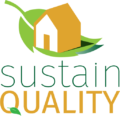Case Study: Net Zero Home
XXResidential Compliance Reports
XXCreating Energy Reliability
Scope Of The Project
Sustain Quality was commissioned to review the energy strategy and provide a sustainability and energy statement for The Hillside Glasshouse, in Hertfordshire. The proposed development is an ambitiously designed four-bedroom house covering around 530 square metres, which already meets the UK government’s 2030 net zero carbon emissions target.
Based on site plans provided, the sustainability and energy statement calculated the proposed development’s predicted energy consumption and CO2 emissions using the energy hierarchy (‘Be Lean, Be Clean, Be Green’). This assessed in turn the feasibility of reducing the energy demand of the building, using energy more cleanly, and applying renewable technologies using net zero carbon design guidelines set by the UK Green Building Council (UKGBC) and the London Energy Transformation Initiative (LETI).
Tools For Tasks Implementation
The energy statement consulted national and local planning requirements and building regulations. It also referred to the United Nations Sustainable Development Goals (SDGs) and followed guidelines set by the UKGBC and LETI for good net zero carbon design principles. These include measuring and disclosing carbon, reducing energy demand, generating balance from renewables, and improving verification and rigour.
In order to predict the development’s energy performance, an energy model was created using software with an approved standard method and procedure SAP interface. The statement also reviewed national and local planning policies and building regulations.
Challenges For Tasks Implementation
The Hillside Glasshouse is a unique design with glass covering the external façade. It adopts Passive House strategies such as orientation, windows and daylighting, without mechanical ventilation. The statement also combines guidance from different sources.
As the Hillside Glasshouse was still in its planning stages, the building’s predicted energy consumption and CO2 emissions were based on site plans and not the completed development.
Solutions
With the UK government announcing that all building must be zero carbon by 2030, the proposed development needs to be constructed and maintained to zero carbon principles throughout its lifetime. The report carefully considered the feasibility of the proposed design and U-values used, and appraised it in line with the energy hierarchy, including:
Be lean – reducing the energy demand of the building.
The report summarised the passive design measures which reduce energy demand within the building, without triggering an energy requirement in the process. These included floor, external walls and window U-value limiting values and targets.
Be clean – investigating the feasibility of clean technologies.
The report recognised that, early on in the design stage, the design team had considered the benefits of adopting on site technologies, including combined heat and power (CHP) and combined cooling heat and power (CCHP), and district heating.
Be green – investigating the feasibility of using on-site renewable and low and zero carbon energy technologies.
The report assessed potential renewable technologies for their applicability to the development. A secondary assessment was then completed to further investigate the remaining technologies that were found to be potentially feasible, including photovoltaics and ground source heat pump.
Key Achievements
The report forms the basis of an energy strategy for the development. Through the use of renewable energy technologies, it aims to achieve 102% carbon reduction over building regulations standards. This means the building will generate more energy than it needs, resulting in a truly net zero home.
Design principles recommended by the report would also result in the development meeting the National Planning Policy Framework standards, the energy performance requirements of Building Regulations Part L2A, and demonstrate compliance with low carbon energy development principles outlined in Herefordshire council’s Local Plan Core Strategy.
The proposed development will also exceed the net zero carbon definition set out in the UKGBC and LETI guidelines.
Benefits For Clients
The report supports the developers of The Hillside Glasshouse to deliver a highly sustainable building that already meets the UK government’s 2030 net zero carbon emissions target. The design measures identified in this report also demonstrate the client’s commitment to sustainable development in line with the UN SDGs, and to fulfilling future requirements over and above those stated in the local development framework.
